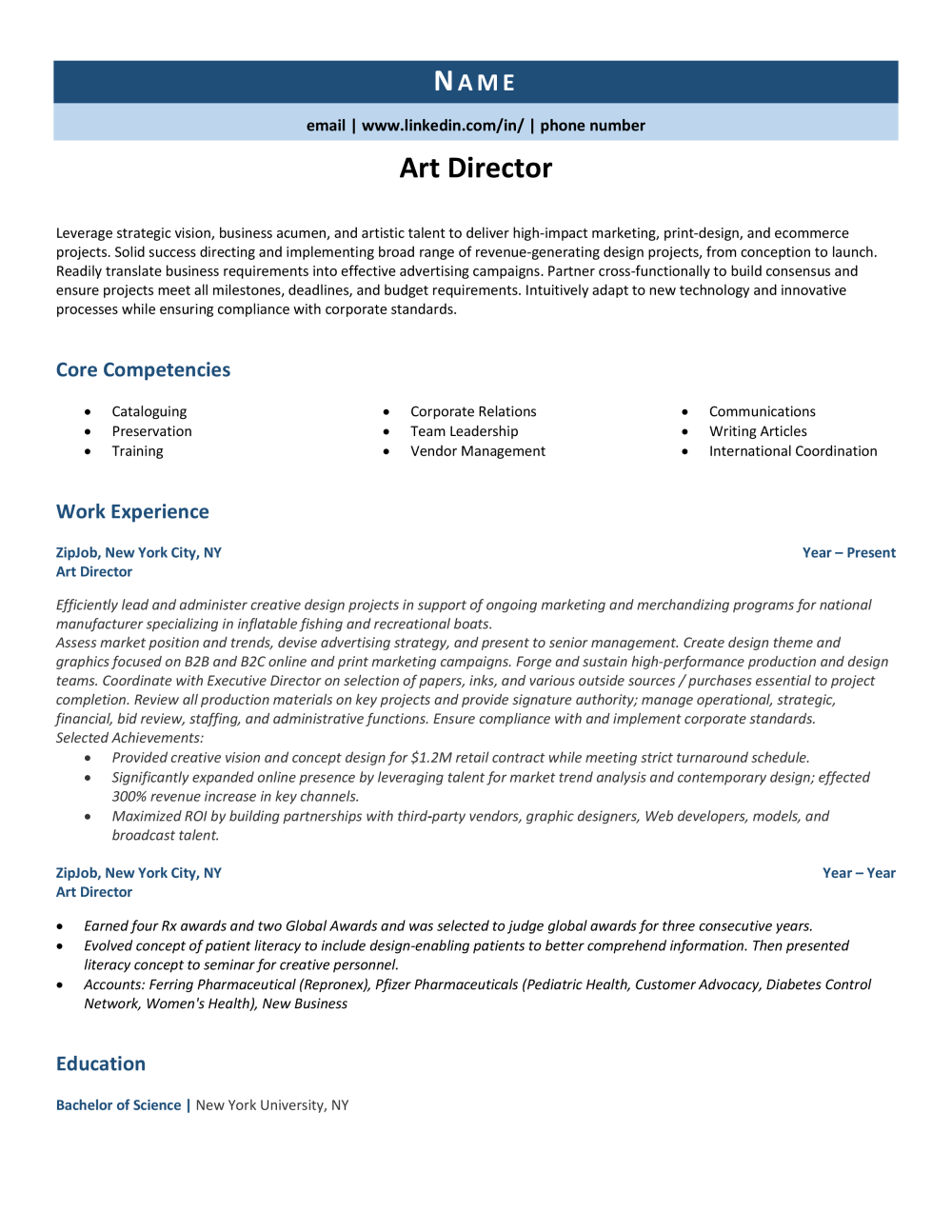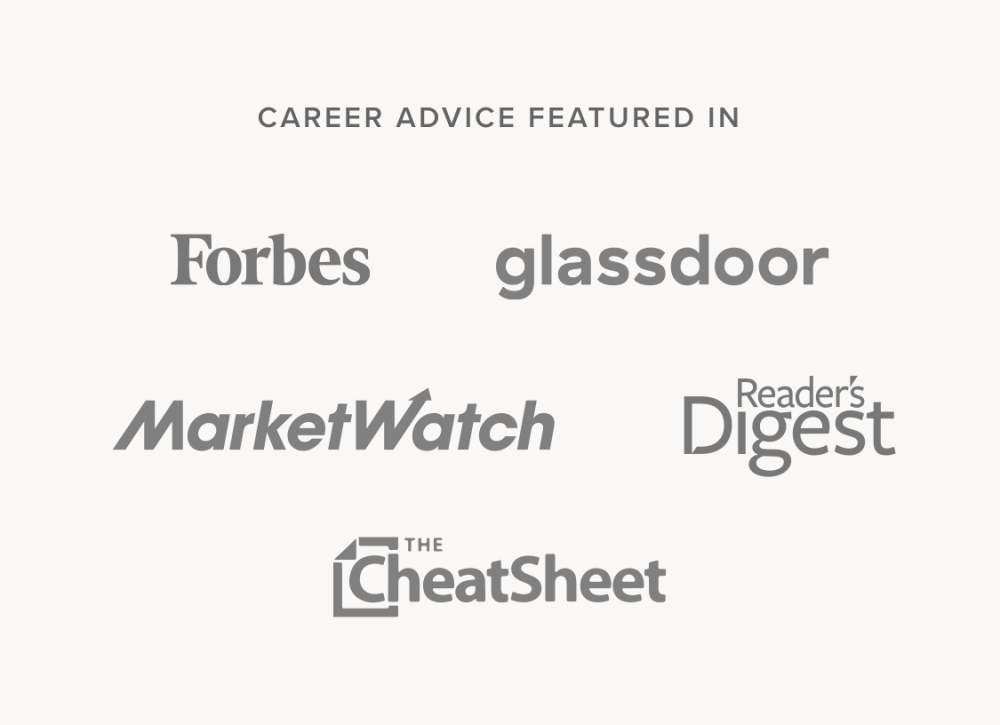Art Director Sample
Download and customize our resume template to land more interviews. Review our writing tips to learn everything you need to know for putting together the perfect resume.
An Art Director oversee the design aspect of advertising and marketing campaigns. Below is a general Art Director job description: Art directors coordinate concept-and-design efforts for promotions which may be in print form, on websites, or in commercials, and they may be involved in consumer promotions, as well. Usually, art directors are more focused on the concept and will delegate work to graphic designers, photographers, and other artists; however, it is still important to be proficient in Photoshop and other design suites in order to lead others' efforts and fill in when necessary. Payscale
Expert Tip
You should never use a creative resume
Many job seekers think that an eye-catching resume template will help them stand out to hiring managers and increase their chances of landing an interview. This is a myth put out by resume builders that value design over content.
The truth is that most hiring managers prefer a traditional resume format.
Creative resume templates, like the one pictured here, can actually hurt your chances of landing an interview. Instead, you should use a basic resume format that quickly communicates your basic information and qualifications–like the one included below.
Art Director resume (text format)
How confident are you feeling about your resume? If you need more help, you can always refer to the following resume sample for a position.
Name
Title
City, State or Country if international
Phone | Email
LinkedIn URL
ART DIRECTOR PROFESSIONAL
Leverage strategic vision, business acumen, and artistic talent to deliver high-impact marketing, print-design, and ecommerce projects. Solid success directing and implementing broad range of revenue-generating design projects, from conception to launch. Readily translate business requirements into effective advertising campaigns. Partner cross-functionally to build consensus and ensure projects meet all milestones, deadlines, and budget requirements. Intuitively adapt to new technology and innovative processes while ensuring compliance with corporate standards.
CORE COMPETENCIES
Cataloguing
Preservation
Training
Corporate Relations
Team Leadership
Vendor Management
Communications
Writing Articles
International Coordination
PROFESSIONAL EXPERIENCE
Art Director
ZipJob, New York NY | Year to Year
Responsibilities
Efficiently lead and administer creative design projects in support of ongoing marketing and merchandizing programs for national manufacturer specializing in inflatable fishing and recreational boats. Assess market position and trends, devise advertising strategy, and present to senior management. Create design theme and graphics focused on B2B and B2C online and print marketing campaigns. Forge and sustain high-performance production and design teams. Coordinate with Executive Director on selection of papers, inks, and various outside sources / purchases essential to project completion. Review all production materials on key projects and provide signature authority; manage operational, strategic, financial, bid review, staffing, and administrative functions. Ensure compliance with and implement corporate standards. Selected Achievements:
Provided creative vision and concept design for $1.2M retail contract while meeting strict turnaround schedule.
Significantly expanded online presence by leveraging talent for market trend analysis and contemporary design; effected 300% revenue increase in key channels.
Maximized ROI by building partnerships with third-party vendors, graphic designers, Web developers, models, and broadcast talent.
Art Director
ZipJob, New York NY | Year to Year
Responsibilities
Earned four Rx awards and two Global Awards and was selected to judge global awards for three consecutive years.
Evolved concept of patient literacy to include design-enabling patients to better comprehend information. Then presented literacy concept to seminar for creative personnel.
Accounts: Ferring Pharmaceutical (Repronex), Pfizer Pharmaceuticals (Pediatric Health, Customer Advocacy, Diabetes Control Network, Women's Health), New Business
EDUCATION
Complete School Name, City, St/Country: List Graduation Years If Within the Last Ten Years
Complete Degree Name (Candidate) – Major (GPA: List if over 3.3)
Relevant Coursework: List coursework taken (even include those you are planning on taking)
Awards/Honors: List any awards, honors or big achievements
Clubs/Activities: List clubs and activities in which you participated
Relevant Projects: List 2-3 projects you have worked on
Everything you need to write your art director resume
Now that you’ve seen an example of a job winning Art Director resume, here are some tips to help you write your own. You should always begin with a summary section. Remember to use basic formatting with clear section headings and a traditional layout. Finally, be sure to include top skills throughout your resume. We’ve included several examples common for Art Director below.
Let’s start with your resume summary section.
1. Summary
The resume summary replaces the out-of-date resume objective. A summary outlines the most impressive parts of your resume for easy recall by your potential employer, while also serving to fill in personal qualities that may not appear elsewhere on the page. Remember that summaries are short and consist of pithy sentence fragments! You can check out the Art Director resume example for more information!
Expert Tip
Always start with your most recent positions at the top of your resume. This is called reverse-chronological format, and keeps your most relevant information easy for hiring managers to review.
2. Formatting
Our experts recommend you start your resume with a resume summary, like the one above. Other common sections are Work Experience, Education, and either Skills or Core Competencies. Here are some guides from our blog to help you write these sections:
Some resumes will include other sections, such as Volunteer Experience or Technical Skills. When it comes to what sections you need to include on your resume, you will know best!
Other sections for you to consider including are foreign language skills, awards and honors, certifications, and speaking engagements. These could all be relevant sections for your resume.
3. Appropriate skills
Your resume should include all your skills that are relevant to your target job. Skills include both hard skills and soft skills. Hard skills are the technical know-how you need to complete a job, such as data analysis or HTML. You can include hard skills in your core competencies section. Soft skills are harder to quantify, so they require more information to explain your aptitude. Some top soft skill examples include communication, problem solving, and emotional intelligence. Use several examples of how you use your key soft skills throughout your work history, profile summary, and resume title.
4. Experience section
Your Work Experience section should make up the bulk of your resume. This section should include your relevant job titles, companies that employed you, and the dates you were employed.
Your Work Experience section should make up the bulk of your resume. This section should include your relevant job titles, companies that employed you, and the dates you were employed. Most people will finish this section by listing daily duties in short bullet points. Don't be one of them! To make your resume stand out, you need to add your accomplishments and key skills to your resume's Work Experience section. Here are three tips from our experts:
Use the STAR method to describe a situation, task, action, and result. This is adapted from a behavioral interview technique, so interviewers will recognize the format. it's also a great chance for you to organize your key accomplishments.
Don't forget about LinkedIn! The majority of employers are going to look you up on LinkedIn, so it's smart to make sure your LInkedIn profile is up to date and include your URL in your resume's contact section.
Always include a cover letter. Not everyone will bother, so it helps you look like a serious job applicant. It's also your chance to introduce yourself: who you are, why you're applying for this job, and how you want to proceed.
Let’s wrap it up!
Standout resumes will include a resume summary, a traditional reverse-chronological layout, and the skills and experience relevant to your job target. This resume example shows how to include those elements on a page. It’s up to you to insert your personal compelling qualifications.
Keep your resume format easy to scan by both humans and computers; our resume template is designed by our experts to satisfy both audiences. And be sure to include your own skills, achievements, and experiences. Job-winning resumes are resumes that successfully market you, leading recruiters and hiring managers to want to learn more!
Finally, emphasize your interest with a customized cover letter. When writing, remember that the resume and cover letter should support each other. Check out our cover letter tips and examples for more advice.
Didn’t get the specific answers you were looking for on this page? Hire a professional resume writer to get the advice you need to land your next job.
Related posts:




